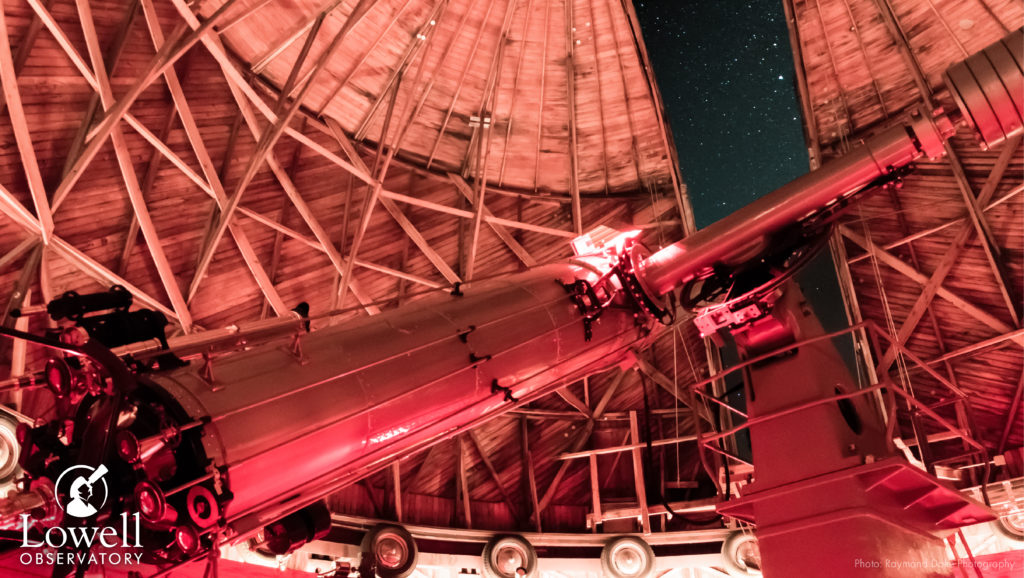
The historic Clark Telescope.
In an increasingly bright world, dark skies are becoming difficult to come by. Light pollution, smog, and man-made objects in Earth’s orbit are making astronomical observation more and more difficult to conduct. International Dark Sky Communities offer some refuge, but it was only as of 2001 that the concept took an official form. That being said, choosing an ideal location for an astronomical observatory has always been a highly selective process, both in the days of Lowell Observatory’s founding and in the modern construction of the Lowell Discovery Telescope in Happy Jack, Arizona. Though the views are breathtaking, the decision to place the 24″ Clark Telescope atop what is now called Mars Hill wasn’t a superficial one. Rather, it was the result of a long, daunting search that took one of the observatory’s first employees on a journey across Arizona.
Testing the Skies
By the time that Percival Lowell put his plans to build an observatory in motion, the factory smog and electric lights of the Industrial Revolution were beginning to spell trouble for viewing conditions in the bustling cities of New England. With its dry air, high altitudes, and rural communities, the American Southwest promised clearer skies. With this in mind, Lowell sent his assistant Andrew Douglass to Arizona to scope out several potential locations for his observatory in February of 1894.
With the 6-inch Clark telescope Lowell had used during his final trip to Japan in hand, Douglass was instructed to make stops in the Arizonan cities of Tombstone, Tucson, Tempe, Prescott, and Flagstaff. At each location, he was to make careful observations of the cosmos and record detailed information about the local atmospheric and astronomical phenomena. The process of vetting potential observatory locations based on this criteria is called site testing. The results of the site tests that Douglass performed throughout his trip were to be compiled into daily reports and telegraphed back to Lowell, who would make the final decision on the best location for his observatory. Douglass stopped first in Tombstone, then worked his way north. As he visited each of the designated locations, he found that, while the desert skies provided far more favorable viewing conditions than those on the east coast, they were far from ideal. Dust, wind, and clouds frequently obscured his view of the cosmos during site testing sessions.
A Small Hill, Just West of Flagstaff
In April of 1894, Douglass arrived in Flagstaff, a rural mountain community nestled among ponderosa pine trees. There, Douglass experienced only favorable weather conditions, allowing him to conduct an extensive series of tests. Based on the daily reports he received from Douglass via telegraph, Lowell identified the area designated as “Site 11,” a small hill just west of town, as the best location for his observatory. He also wired instructions to prepare a telescope installation in time for the fast-approaching opposition of Mars.
The observatory was given five acres of land, including Site 11, by the town of Flagstaff. With the help of local laborers, Douglass assembled the sturdy foundations for a pair of refracting telescopes that Lowell and his colleague William Pickering would soon send along to Arizona. Percival Lowell himself arrived in town on May 28, 1894, and began regular observations of Mars with the two refractors: an 18-inch borrowed from Pittsburgh lensmaker John Alfred, and 12-inch from Pickering’s older brother at Harvard University in Boston. During this time, Lowell and Pickering painstakingly studied the Martian surface, noting changes and irregularities over time.
A Legacy Begins
In 1995, Lowell began making arrangements with the Alvan Clark & Sons Firm of Cambridgeport, Massachusetts to build a state-of-the-art 24-inch refracting telescope. They had built telescopes for Lowell before, but this one was to be the biggest and most powerful one yet. Lowell also tasked Flagstaff bicycle repairmen Stanley and Godfrey Sykes, who claimed to be “competent makers and menders of anything,” with building the telescope’s dome. The telescope itself was completed the following year and dubbed the Clark Telescope, in honor of its builders. It saw first light, meaning that it was used to view the cosmos for the very first time, on the evening of July 23, 1896. The most notable object to be viewed that night was planet Mars, which would continue to be the subject of Lowell’s intensive and controversial studies. Thus, the legacy of Lowell Observatory’s oldest and and most storied telescope began. The future would bring status not only as a piece of astronomical history, but a vital role in capturing the imaginations of the public and popularizing the idea of space research and exploration.